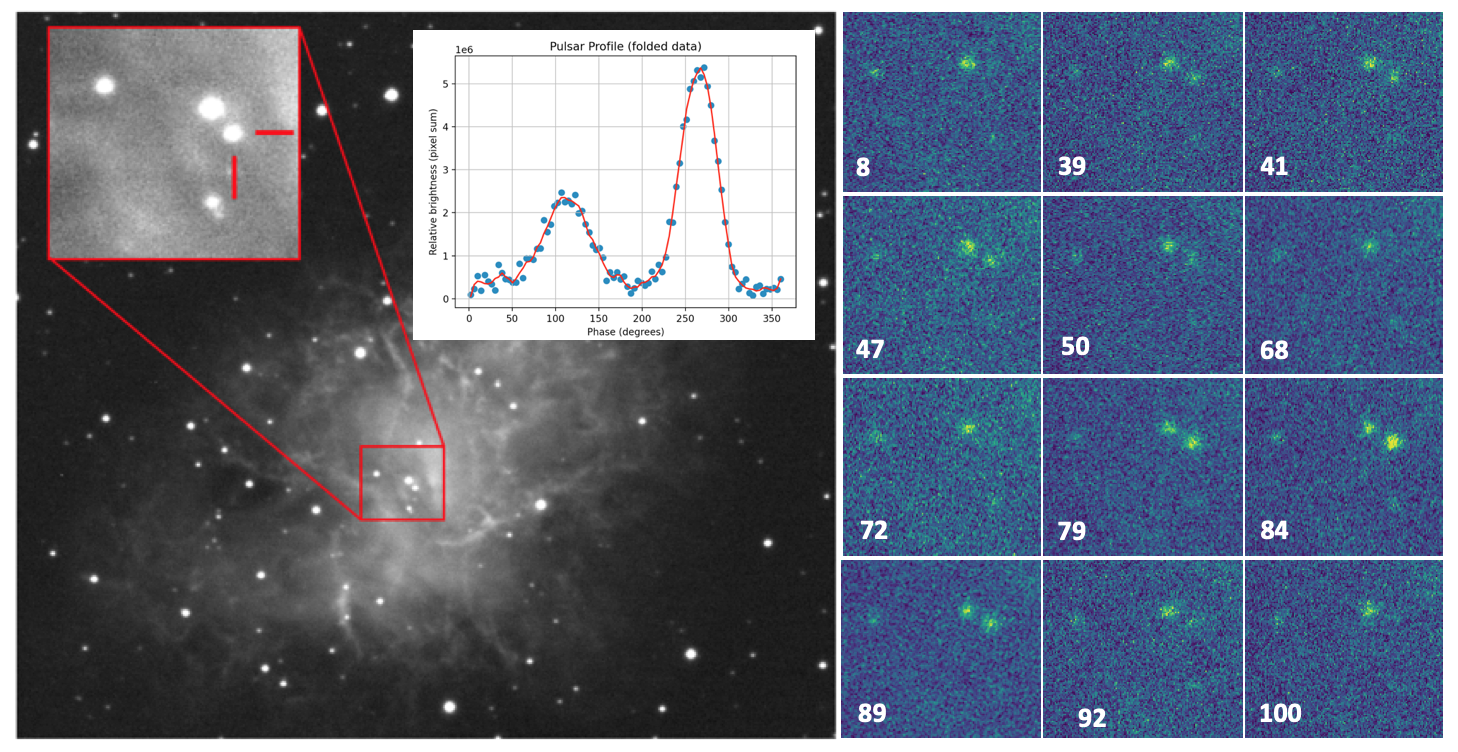Observation by David Hardwick: Light profile of the Crab Nebula pulsar ...
Uploaded by
Observer
David Hardwick
Observed
2022 Jan 29 - 20:00
Uploaded
2022 Dec 09 - 13:48
Objects
The Crab Nebula (M1)
Lightcurve
Equipment
- 14 inch SCT
- ZWO ASI1600MM
Exposure
200x20s
Location
Hill Head, Fareham, UK
Target name
PSR B1919+21
Title
Light profile of the Crab Nebula pulsar (PSR B1919+21)

About this image
200x20s light chopped exposures spanning 2 rotations of the pulsar. Frames were dark adjusted.
The right set of images are selected from initial rotation capture. These show first the arrival of the inter-pulse (8-68) followed by the main pulse (72-100). Note how much brighter the main pulse is.
Left image is of basic stacked image of M1 with insets showing location of pulsar and the measured photometric light profile using folded data from both rotations.
For full details on the process and the results please see article in the BAA journal Dec 2022 (Vol.132 No.6).
Files associated with this observation
Like this image
Comments
This is really impressive. I have a Horizon documentary from 1972 which includes a section describing the first optical detections of the pulsar and they use exactly this technique of a rotating shutter and a TV camera. Here's a link to a clip from that programme:
https://nickdjames.com/Horizon/19711122_Pulsar.mp4
It reminds me how good Horizon used to be.
Nice light curve ! I managed to get a two point On/Off "light curve" using the same technique with a home built camera and an 8 inch scope back in 2003
http://www.threehillsobservatory.co.uk/astro/pulsar_detection_1.htm
and was expecting someone to take advantage of low read noise cameras to do a better job.
It can be done directly without the chopper wheel with EMCCD technology sensors but now CMOS is close to photon counting, I wonder if the same might now be possible using cameras and apertures affordable to the amateur
Hi Nick,
Actually that was not the first measurement. That was done by Mike Disney and John Cocke using an electronic technique to fold the signal from the detector.
https://www.nature.com/articles/221525a0
It is behind a paywall but I remember having an email exchange with Mike Disney about their observation after I had made mine
Here is a great transcript of an interview with Mike Disney describing the discovery
https://www.aip.org/history-programs/niels-bohr-library/oral-histories/4576
Cheers
Robin
Yes, they are on the segment before this on the Horizon programme. I'll post the whole video later, it is really interesting. I don't think they got an image though but they did get a nice lightcurve.
Yes Nick, I remember watching that horizon episode (Crab Nebula) as a 14 year old school boy and being absolutely amazed. Who can forget the voice of Paul Vaughan narrating those wonderful subjects. The days when science programmes were about science! Many thanks for posting the link, much appreciated.
No image. Disney and Cocke used a photomultiplier and an integrator on just an old 36 inch scope and placed it on each potential target in turn using offsets from brighter stars until they found the pulsating one (The radio signal was not sufficient to resolve which star it was). They did not get it all working properly during their allotted slot but by luck got some extra time. It was a baptism of fire for both Disney and Cocke who had never used an observatory telescope before ! The video camera and chopper on the larger scope was much easier
Have you submitted your observations and light curve to the VSS?
Well, it is in the GCVS as CM Tau ...
;-)
The whole Horizon programme is here:
https://nickdjames.com/Horizon/19711122_Crab_Nebula.mp4
It is around 400MB. Lots of young, famous scientists in it. The optical detection part starts around 30 minutes in and includes the Mike Disney observation that Robin mentions. Roderick Wilstrop at Cambridge plays a part too. It also has the wonderfully named Stirling Colgate who set up an early automated supernova search.
It was first broadcast in 1971 and is an excellent example of what top-class science programming was like then. Paul Vaughan was indeed a master narrator.
© British Astronomical Association 2026
Registered charity no. 210769
Registered company no. 117572
For more information including contact details,
click here.
Our Terms of Use are here.
Our Privacy Policy is here.

The BAA image gallery was designed and
built by Dominic Ford.
Image gallery software
©
Dominic Ford
2020–2024
